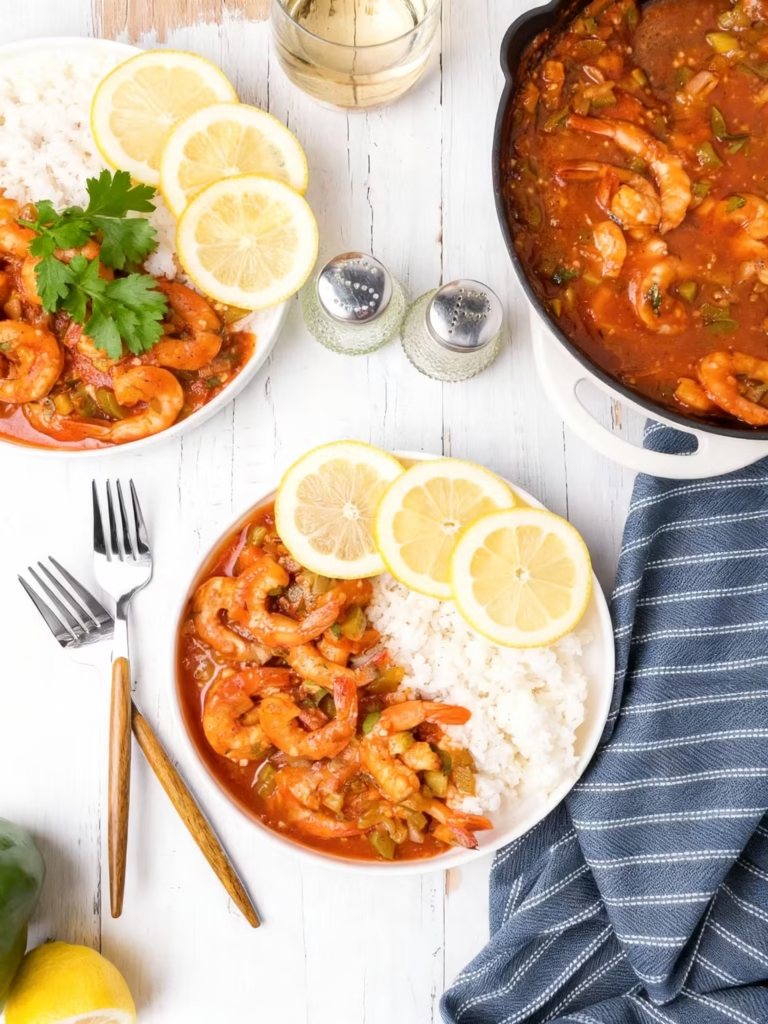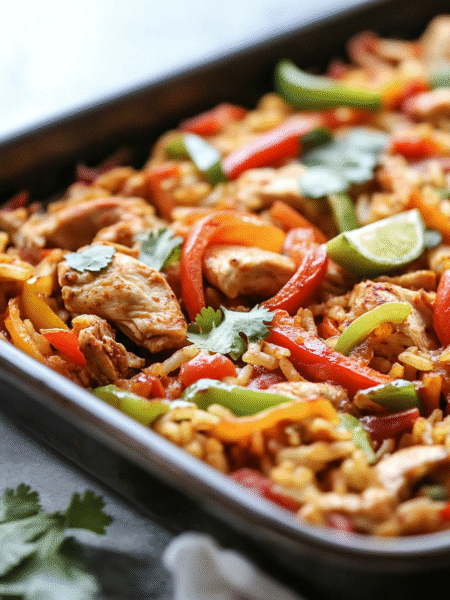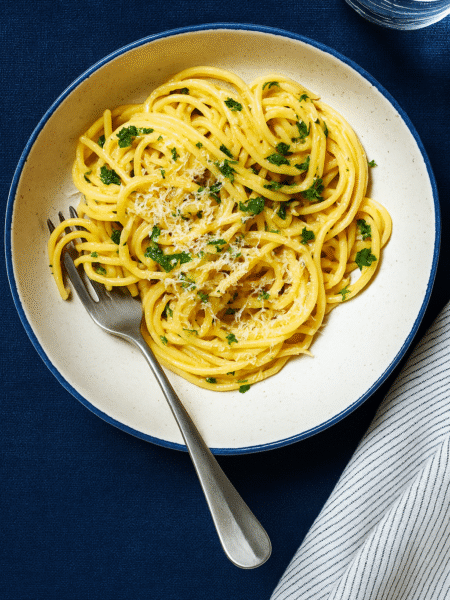Classic Louisiana Shrimp Creole is a vibrant, flavorful dish featuring tender shrimp simmered in a richly seasoned tomato sauce with the “holy trinity” of onion, bell pepper, and celery. This Creole recipe has roots in the multicultural cuisine of New Orleans and delivers bold Cajun-Creole flavors in each bite. It’s surprisingly easy to make at home and comes together in about 45 minutes – perfect for a weeknight taste of the Big Easy.
A pot of classic Shrimp Creole simmering with succulent shrimp and vegetables, ready to be served over rice.
Classic Louisiana Shrimp Creole Recipe
You’ll love how this classic shrimp creole comes together in one pot with simple ingredients. A quick sauté of veggies and spices creates a deeply flavored base, then tomatoes and broth simmer into a hearty sauce. Finally, the shrimp are cooked just until tender in the spicy Creole gravy. It’s a comforting, authentic Louisiana meal that’s easy enough for any home cook to master!
Ingredients to Make Shrimp Creole
Olive Oil
You’ll start with a couple tablespoons of olive oil to sauté the vegetables. Olive oil has a higher smoke point than butter, which helps prevent burning while still adding rich flavor. (Traditional recipes sometimes use a mix of butter and oil for flavor, but olive oil alone works great to keep this dish light.)
Onion, Celery & Bell Pepper (Holy Trinity)
A diced yellow onion, green bell pepper, and a couple of celery stalks form the aromatic base known as the “holy trinity” in Cajun and Creole cooking. This trio is similar to the French mirepoix (onion, celery, carrot) but uses bell pepper instead of carrot. Sauté these until they are “melty” soft – this releases their natural sweetness and tons of flavor into the dish.
Garlic
A few cloves of minced garlic add depth and that classic savory aroma. Garlic cooks quickly, so add it after the other veggies are softened, and sauté just until fragrant (about 30 seconds) to avoid burning.
Diced Tomatoes
A can of diced tomatoes provides the chunky tomato component of the sauce. Tomatoes contribute acidity and natural sweetness, forming the core of the Creole sauce. Using canned diced tomatoes is convenient and gives consistency year-round, but you could substitute fresh ripe tomatoes in season (you may need to simmer a bit longer to break them down).
Tomato Sauce
Tomato sauce adds body and richness to the Creole sauce. It’s smooth and already seasoned, which boosts the overall flavor of the dish. Using a combination of diced tomatoes and tomato sauce creates a stew with great texture (chunks of tomato from the diced tomatoes) and a thick, cohesive base from the sauce.
Chicken Broth
A cup of chicken broth thins out the tomato base just enough to create a sauce that will simmer the shrimp. It also infuses extra savory flavor. You can substitute vegetable broth or even water in a pinch, but a good low-sodium chicken broth will enrich the dish. (If you prefer a thicker Creole, use slightly less broth; you can always add a splash more if needed during simmering.)
Bay Leaves
A couple of dried bay leaves lend an earthy, herbal depth to the sauce. Bay leaves are a classic in long-simmered Creole and Cajun dishes. Toss them into the pot during the simmer and remember to remove them before serving, as they are inedible leaves.
Dried Thyme
Thyme is a key herb in Creole seasoning, bringing a woodsy, peppery note. Even in its dried form, thyme adds a lot of aroma to the dish. Crush the dried thyme between your fingers as you add it to help release its oils. If you have fresh thyme, you can use a few sprigs tied together, removing them along with the bay leaves later.
Paprika
Paprika adds a gentle sweetness and a pop of red color to the Creole sauce. It’s one of the herbs/spices often found in Creole seasoning blends. You can use regular sweet paprika; if you enjoy a smoky flavor, you could substitute half of it with smoked paprika for a smokier Creole (though traditional Louisiana recipes typically use the standard paprika).
Cayenne Pepper
Cayenne brings the heat. 1/2 teaspoon of cayenne will give a moderate kick to your Shrimp Creole, but you can adjust this to taste. This dish is meant to have a bit of spiciness from cayenne or hot pepper sauce, but it shouldn’t be overwhelmingly hot. If you’re spice-sensitive, start with a smaller pinch – you can always add more later. Love spice? Feel free to add a bit extra cayenne or a few dashes of your favorite Louisiana hot sauce at the end.
Shrimp
The star of the dish! You’ll need about one pound of large shrimp, peeled and deveined. Large (16/20 count) shrimp are ideal – they’re plump and juicy, and won’t overcook too quickly. Wild-caught shrimp tend to have better flavor and texture (and hold up better if you have leftovers). If your shrimp are frozen, thaw them in the refrigerator overnight or in a bowl of cold water before cooking. Pat the shrimp dry and remove tails (if still on) for easier eating.
Fresh Parsley
Chopped fresh parsley is stirred in at the end and used as a garnish. It provides a burst of fresh, grassy flavor that brightens up this rich dish. Don’t skip the parsley – that fresh green note really balances the savory tomato sauce and looks appealing against the red sauce.
Salt & Black Pepper
These staple seasonings are added to taste to bring out all the flavors. You’ll sauté the veggies with a pinch of salt to help them release moisture, and season the sauce and shrimp with more salt and freshly ground black pepper as needed. Remember that the broth and canned tomatoes may contain some salt, so taste as you go. Fresh-cracked black pepper adds a subtle heat and aroma that complements the cayenne.
White Rice (for serving)
Shrimp Creole is traditionally served over plain white rice, which soaks up that delicious sauce. Use steamed or boiled long-grain white rice (like Louisiana-grown rice if available) for authenticity. For a healthier twist, you could serve it with brown rice or even cauliflower rice (for a low-carb option), but classic Creole cooking sticks with simple white rice as the bed for the flavorful shrimp and sauce.
How to Make Shrimp Creole

- Sauté the Holy Trinity: Heat the olive oil in a large heavy-bottomed pot or deep skillet over medium heat. Add the diced onion, green bell pepper, and celery. Cook, stirring occasionally, for about 8-10 minutes until the vegetables are very soft and beginning to caramelize. Adjust the heat as needed so they soften but do not burn – you want them almost meltingly tender to form a flavorful base.
- Add Garlic and Seasonings: Stir in the minced garlic, dried thyme, paprika, cayenne pepper, and the bay leaves. Cook for about 30 seconds to 1 minute, stirring constantly, until the garlic is fragrant and the spices are lightly toasted. Tip: Adding the spices to the hot oil with the veggies helps “bloom” their flavors, intensifying the seasoning throughout the dish.
- Add Tomatoes and Simmer: Pour in the can of diced tomatoes (with their juices), tomato sauce, and chicken broth. Stir well, scraping up any browned bits from the bottom of the pan (that’s flavor!). Bring the mixture to a boil, then reduce the heat to low. Let it simmer uncovered for about 10-15 minutes, allowing the sauce to thicken slightly and the flavors to come together. Stir occasionally to prevent sticking. (If it thickens too much, you can add a splash of extra broth or water. If it’s too thin, continue simmering a bit longer.)
- Cook the Shrimp: Add the peeled and deveined shrimp to the simmering sauce. Make sure the shrimp are submerged in the sauce. Cook for about 3-5 minutes, stirring occasionally, until the shrimp turn pink, opaque, and curl into a “C” shape. Large shrimp will take around 4 minutes to cook through. Be careful not to overcook the shrimp – they cook quickly and will become tough if left too long.
- Finish with Parsley and Season to Taste: Turn off the heat. Remove and discard the bay leaves. Stir in the chopped fresh parsley. Taste the Creole sauce and add salt and pepper as needed. If you want more heat, add a few dashes of hot sauce or a pinch more cayenne now. The sauce should be well-seasoned, tangy, and spiced just right.
- Serve: Spoon the shrimp and plenty of sauce over a bed of hot cooked white rice in each bowl or plate. Garnish with extra parsley if desired. Enjoy your Classic Louisiana Shrimp Creole while it’s hot! (As they say in New Orleans, “Laissez les bons temps rouler!” – let the good times roll!)
Tips for Making the Best Shrimp Creole
- Cook Vegetables Thoroughly: Take the time to sauté the onion, bell pepper, and celery until they are very soft and almost caramelized. The “holy trinity” should be almost melting – this releases maximum flavor into the sauce and is key to an authentic taste.
- Bloom the Spices: Add the dried thyme, paprika, cayenne, and bay leaves to the hot oil with the vegetables before adding liquid. Cooking the spices in oil for a minute helps bloom their flavors, making the dish more fragrant and richly flavored.
- Adjust the Heat Level to Taste: It’s easier to add heat than to remove it. Start with the recommended 1/2 teaspoon of cayenne (or less if you’re sensitive). You can always stir in more cayenne or hot sauce at the end if you want it spicier, but you can’t take it out once added. Taste as you go to get the perfect level of spice.
- Don’t Overcook the Shrimp: Shrimp become rubbery when overcooked. Aim to remove the shrimp from heat as soon as they are opaque and curl into a C-shape. They will continue to cook slightly from residual heat. If your sauce needs more simmering time, do it before adding the shrimp, not after.
- Use Quality Shrimp: For best results, use good-quality large shrimp, preferably wild-caught if available. They have better flavor and are more forgiving with cooking. If using smaller shrimp, reduce the cooking time accordingly.
- Prep Everything Beforehand: Once you start cooking, things move quickly. Have all your ingredients chopped, measured, and ready to go (mise en place). This will make the process seamless and prevent any garlic or spices from burning while you’re scrambling to open a can.
Variations
- Extra Protein: While shrimp is traditional, you can add sliced andouille sausage for a heartier Creole stew (brown the sausage with the vegetables at the start). Other seafood like crawfish or even chunks of firm fish can be added or substituted for the shrimp in this recipe, essentially creating other types of Creole stew.
- Add Okra: For a Southern twist, add a cup of sliced okra to the pot along with the other vegetables. Okra will give the sauce a thicker texture (as it releases its natural thickening juices) and extra flavor. This starts to blur the line towards a gumbo (which often includes okra), but it’s a delicious addition if you enjoy it.
- Tomato Variations: If you want a smokier, fire-roasted flavor, use fire-roasted diced tomatoes. You can also add a tablespoon of tomato paste for an even thicker, more robust tomato flavor.
- Herb Swap: If you don’t have dried thyme, Italian seasoning or dried oregano can work in a pinch to provide herbal notes. Some cooks also add a bay leaf in addition to the thyme for extra depth.
- Lower-Carb Option: Serve your Shrimp Creole over cauliflower rice instead of white rice for a low-carb meal. The sauce is so flavorful that it will still be delicious.
- Citrus Finish: A squeeze of fresh lemon juice right at the end (or served as wedges on the side) can brighten up the dish and complement the richness of the tomato and shrimp. It’s not traditional in the recipe itself, but a lemon wedge is often provided in New Orleans restaurants for those who want a zing of acidity.
What is Shrimp Creole?
Shrimp Creole is a classic Louisiana Creole dish consisting of shrimp cooked in a savory tomato-based sauce with the “holy trinity” of onion, celery, and bell pepper, typically seasoned with cayenne pepper or hot sauce. It originated in New Orleans, reflecting the city’s Creole heritage of French, Spanish, and African influences. Shrimp Creole is usually served over steamed white rice as a hearty main course. It’s different from Cajun shrimp étouffée, which has a roux-thickened gravy instead of a tomato base, and from gumbo, which is more soup-like and often uses a roux or okra as a thickener. In short, Shrimp Creole is a spiced tomato stew with shrimp that embodies the flavors of New Orleans cuisine.
Is Shrimp Creole Spicy?
Shrimp Creole has a mild to moderate spiciness, but it’s very customizable. The heat in this dish comes from cayenne pepper and sometimes a few dashes of hot sauce. By default, most recipes (including this one) have a gentle kick – enough to notice, but not fiery. If you’re sensitive to spice, you can reduce the cayenne or omit it entirely and skip the hot sauce, resulting in a milder but still flavorful stew. If you love heat, you can increase the cayenne pepper, add extra hot sauce, or even include a spicy Creole seasoning blend. The beauty of Shrimp Creole is that you can adjust the spice level to your taste. Remember, it’s easier to add more spice at the end than to fix an overly spicy dish, so taste as you go.
Can I Make Shrimp Creole Ahead of Time?
Yes, you can make Shrimp Creole ahead of time, with a few considerations. The best approach is to prepare the sauce base in advance, but cook the shrimp right before serving. You can fully cook the vegetable and tomato sauce (without adding the shrimp) and store it in the refrigerator for up to 2-3 days. When you’re ready to serve, reheat the sauce on the stove until simmering, then add the raw shrimp and cook for a few minutes until done. This way, the shrimp will be perfectly cooked and juicy. If you add and cook the shrimp ahead of time, they might become rubbery when reheated. So, for make-ahead, cook the sauce in advance and add the shrimp later.
If you need to make the entire dish ahead, you can – but be very careful reheating so as not to overcook the shrimp. Cool the cooked Shrimp Creole quickly and store it in the fridge. Reheat gently in a saucepan over low heat until just warmed through, adding a splash of water or broth if the sauce has become too thick, and stirring frequently.
Storing Shrimp Creole
If you have leftovers, let the Shrimp Creole cool to near room temperature, then store it in an airtight container in the refrigerator. It will keep for about 3-4 days when properly refrigerated. The flavors may even deepen over a day or two. For best results, store the rice separately from the shrimp and sauce (to prevent the rice from absorbing too much liquid). Combine them when reheating and serving.
Freezing Shrimp Creole
You can freeze Shrimp Creole, but for best results consider freezing the sauce without the shrimp. The tomato-based sauce itself freezes very well. Transfer the cooled sauce (with the vegetables, but no shrimp) to a freezer-safe container and freeze for up to 1-2 months. When you’re ready to serve, thaw the sauce in the refrigerator overnight and bring it to a simmer on the stove, then add fresh or thawed raw shrimp to cook through.
If you want to freeze fully cooked Shrimp Creole (with the shrimp in it), you can, but keep in mind the texture of the shrimp may suffer upon thawing and reheating (they can become a bit chewy). If freezing leftovers that already include the shrimp, use them within 1-2 months for best quality. Thaw in the fridge and reheat gently as described below.
Reheating Shrimp Creole
The best way to reheat Shrimp Creole is on the stovetop. Place the leftover creole (sauce and shrimp) in a saucepan. Heat over low to medium-low heat, stirring occasionally, until it’s warmed through. To prevent the sauce from drying out or becoming too thick, add a tablespoon or two of water or broth during reheating if necessary. Be patient and use gentle heat – this will ensure the shrimp don’t get overcooked. Heat just until the shrimp and sauce are hot; avoid boiling.
If you’re in a hurry, you can microwave Shrimp Creole, but do it in short bursts at lower power, stirring in between, to avoid toughening the shrimp. (On the stovetop you have more control and will get a better texture.)
What to Serve with Shrimp Creole
The traditional accompaniment to Shrimp Creole is steamed white rice, which we’ve already covered. A slice of crusty French bread or a warm baguette is fantastic on the side – perfect for sopping up every drop of the delicious Creole sauce. You can also serve a simple green salad or some sautéed greens (like collard greens or kale) on the side to add a fresh element to the meal. For a cooling contrast, consider a creamy cucumber salad or coleslaw, especially if you made your creole extra spicy. And don’t forget to put out the hot sauce (such as Tabasco) on the table – some folks may want to splash a little more on their serving for extra kick!

Easy Classic Louisiana Shrimp Creole Recipe
Description
A vibrant, spicy tomato-based stew loaded with plump shrimp, the holy trinity of vegetables, and Cajun-Creole soul.
Ingredients
Instructions
-
Heat olive oil in a large skillet or Dutch oven over medium heat.
-
Add onion, bell pepper, and celery (the holy trinity) and sauté until softened, about 5-7 minutes.
-
Stir in garlic and cook for 1 minute until fragrant.
-
Pour in diced tomatoes, tomato sauce, chicken broth, bay leaves, thyme, paprika, and cayenne.
-
Bring to a simmer, then reduce heat and cook for 15-20 minutes, allowing flavors to meld.
-
Season the shrimp with salt and pepper, then add to the skillet.
-
Cook shrimp for 3-5 minutes until pink and cooked through.
-
Remove bay leaves, stir in fresh parsley, and adjust seasoning if needed.
-
Serve hot over cooked white rice.
Nutrition Facts
Servings 4
- Amount Per Serving
- Calories 320kcal
- % Daily Value *
- Total Fat 10g16%
- Sodium 980mg41%
- Total Carbohydrate 25g9%
- Dietary Fiber 4g16%
- Sugars 8g
- Protein 28g57%
* Percent Daily Values are based on a 2,000 calorie diet. Your daily value may be higher or lower depending on your calorie needs.
Note
For deeper flavor, let the sauce simmer longer before adding shrimp. Don't overcook the shrimp—they should be just pink and tender.






